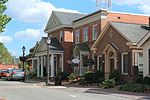T.C. Walker House

T.C. Walker House is the historic home of a lawyer, county supervisor, and a school superintendent who was enslaved prior to the American Civil War. It is at 1 Main Street in Gloucester, Gloucester County, Virginia and was built about 1880, and is a two-story, U-shaped, frame vernacular dwelling with traces of Greek Revival and Gothic Revival styles. It has a cross-gable roof, two-bay addition, and front porch. It was the home of Thomas Calhoun "T.C." Walker, who worked tirelessly to improve African-American land ownership and educational opportunities. As a lawyer he represented many African American clients. He purchased the home in 1900. The house was donated to Hampton University in 1977.Walker wrote an autobiography titled The Honey-Pod Tree. He was buried at the Bethel Baptist Church Cemetery. The home was added to the National Register of Historic Places in 2009.
Excerpt from the Wikipedia article T.C. Walker House (License: CC BY-SA 3.0, Authors, Images).T.C. Walker House
Main Street,
Geographical coordinates (GPS) Address External links Nearby Places Show on map
Geographical coordinates (GPS)
| Latitude | Longitude |
|---|---|
| N 37.413055555556 ° | E -76.521944444444 ° |
Address
T.C. Walker House
Main Street 6739
23061
Virginia, United States
Open on Google Maps






